A couple of weeks ago, I wrote a post about phonological awareness interventions for struggling readers. I described different phonological and phonemic awareness skills, and I suggested different activities for teaching these skills.
But the skills and activities were all in English. And if you teach in Spanish (like me), you might be wondering if you should teach the same phonological awareness skills to your Spanish-speaking bilingual students.
The answer? Yes and no. Students who are learning to read in Spanish benefit from developing phonological awareness skills in Spanish. And because Spanish and English are structured slightly differently, there are differences in the types of phonological awareness skills that students should practice.
In today’s post, I’ll describe different phonological awareness skills that are helpful for children who are developing Spanish literacy skills. I’ll also provide free phonological awareness activities that you can try out with your students!
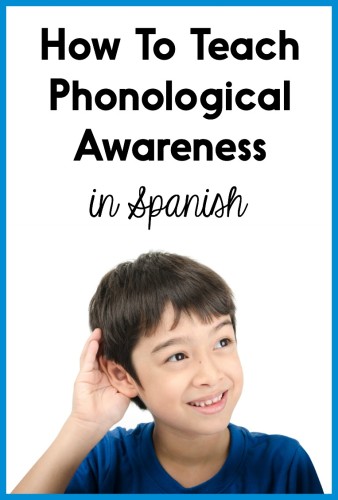
Why should we teach phonological awareness in Spanish?
Before we dive into how to teach phonological awareness in Spanish, we have to determine if it’s worth teaching at all (spoiler alert – it is!).
Phonological awareness is an awareness of the sounds that make up spoken language. When we’re talking about phonological awareness, it doesn’t have anything to do with written letters (that would be phonics).
Research has shown that for young English-speaking children, developing phonological awareness can help them learn to read and write.
Research also shows that strong phonological awareness in Spanish speaking children is correlated with success in emergent spelling (Manrique and Signorini, 1994). In other words, students who receive phonological awareness training are better able to spell words phonetically than students who do not receive the same training.
One reason for this is that Spanish has a “transparent orthography” (Gorman and Gillam, 2003). This means that there’s a strong relationship between the spoken sounds and the letters with which they’re represented. Spanish words are pretty easy to spell, as opposed to English words (especially those with complex vowel spelling patterns).
It only makes sense, then, that if a child is highly aware of the spoken sounds of Spanish, it’s going to be relatively easy for her to represent those sounds with letters when she’s writing words.
My own, not-official research has also taught me that phonological awareness in Spanish is helpful with word reading. I’ve seen that some children are able to read syllables individually but not put them together to make words. Phonological awareness activities like oral syllable blending have been helpful in getting my students to blend syllables together when reading.
Now let’s move on to some more practical and concrete stuff. 🙂
What Spanish phonological awareness skills should we teach?
Just like in English, there seems to be a continuum of Spanish phonological awareness skills (Gorman and Gillam, 2003). Some skills are easier than others. Students may progress along this continuum of skills as their phonological awareness “grows.”
However, in this post, I’m going to start with the most important skill (rather than the easiest skill). I’ll first discuss syllable segmentation and blending because syllables are such an important part of the Spanish language.
I’ll then touch on rhyming, initial phoneme matching, initial and final sound identification, and phoneme identification placement. Practicing all of these skills may be helpful to young students who are developing emergent (early) literacy skills in Spanish.
Working with syllables
Because Spanish is a syllabic language, I devote a big chunk of my phonological awareness instruction to working with syllables. Below are some of the activities we do.
Syllable blending
I’ve found that syllable blending is the easiest “syllable skill” for kids to learn. To practice, the teacher says the syllables in a word (“ven-ta-na”) and the children have to say the complete word (“ventana”).
Whenever I have a minute here or there, I say the syllables in a word and have students figure out the “mystery” word. You can do this with students’ names or classroom objects to really get them excited.
When students need more practice with this skill, I have them practice in a small group setting. I give them game mats (like the ones shown below) and counters. I say the syllables of a word, and if they have the corresponding picture on their mat, they get to cover it with a counter. The first person to cover all of his or her circles is the winner!
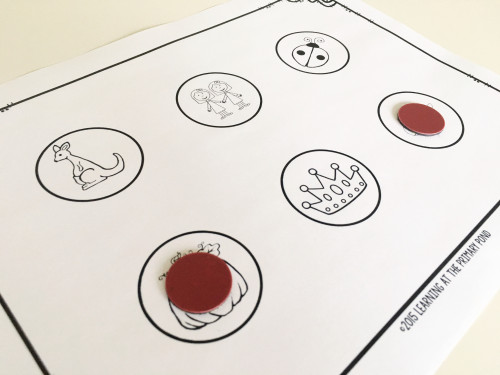
Click here for a link to some free Spanish writing materials!
Syllable segmentation
Syllable segmentation is breaking words up into their syllables (the opposite of syllable blending). For example, if the teacher says “elefante,” the students say “e-le-fan-te.” I love to incorporate movement into syllable segmentation! You can have kids clap, tap their hands, tap their feet, or move their hands as they break words up into their syllables.
I try to squeeze in syllable segmentation whenever possible. When I taught bilingual Kindergarten, I always started with students’ first and last names. They love it when it’s their turn for the class to “break up” their name into syllables! Some of your kids may need a little extra support with this. Try using syllable puzzles like the one shown in the photo below – have students put a puzzle together and then tap or move each piece as they say each syllable.
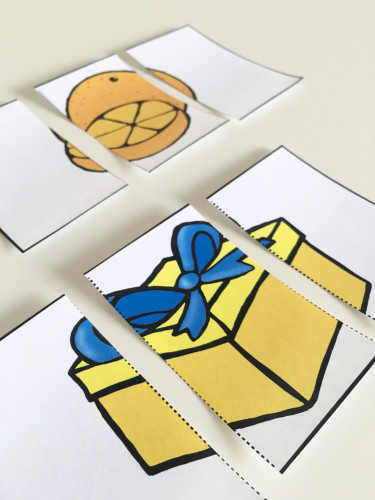
To download some of these puzzles for free, just put in your information in the boxes below! (If you already put in your info above for the syllable blending activity, you don’t need to put it in again.)
Success! Check your email right away to download your freebie!
Blending phonemes to make syllables
Although Spanish is a syllabic language, I’ve found that students also need to be aware of the individual sounds that make up syllables (i.e. the sounds /m/ and /a/ in the syllable “ma”). This helps them tremendously as they learn to spell and read words.
Just like with syllable blending and segmenting, I squeeze in phoneme blending whenever I have a spare minute. For instance, I might say /p/ /e/ and students have to guess that the “mystery syllable” is “pe.”
About a year ago, I created a “blending sheet” to help my struggling readers practice blending phonemes into syllables. It has helped tremendously!
To use this sheet, I sit next to one student. I say two sounds in a syllable, touching one dot as I say each sound. The student then slides their finger across the arrow, blending the sounds together to make the syllable.
It goes like this:
Teacher: /m/ (touch), /i/ (touch)
Student: (slides finger across arrow) mi

Incorporating visuals (the symbols on the sheet), movement, and saying sounds aloud has been really effective with getting my students to blend phonemes.
I also make sure to explicitly tell them that this activity helps them read and write words. I’ll also pull the sheet out if we’re reading or writing and students need to blend two phonemes together to make a syllable.
The blending sheet is also included in your free download.
Breaking up syllables into their phonemes
In my opinion, the “hardest” syllable skill is breaking up syllables into their individual phonemes (i.e. when the teacher says “ru,” the child can say /r/ /u/).
This isn’t difficult for all students, but many of my struggling readers do have trouble with this skill. We practice orally on a daily basis, and we can also use the blending sheet pictured above.
When we practice this skill using the blending sheet, I’m the one who says the complete syllable while sliding my finger across the arrow. The student has to then break up the syllable into its individual sounds, touching each dot as he says each sound.
Touch lights are another fun tool for practicing breaking up syllables into their phonemes! Say a 2-sound syllable aloud, and the student has to say each sound individually, tapping on one light for each sound:
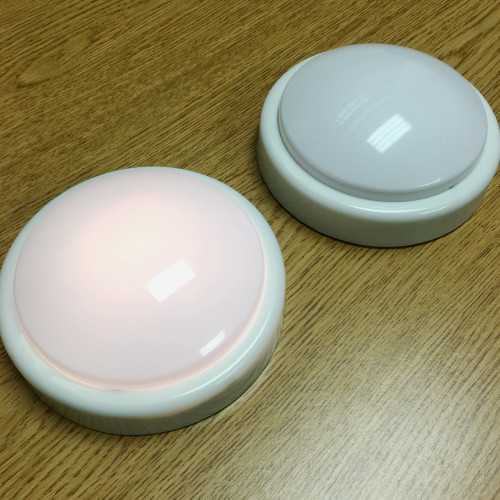 I’ve found that this skill develops through time and practice. As students become better at breaking syllables up into sounds, they are better able to write syllables and less likely to leave out sounds.
I’ve found that this skill develops through time and practice. As students become better at breaking syllables up into sounds, they are better able to write syllables and less likely to leave out sounds.
Other Phonological Awareness Activities
Although I spend most of my phonological awareness instruction time on syllable-related activities, there are other skills that students can benefit from learning. Below, I list these skills and suggest ways to practice them.
Rhyming
Students can practice matching words that rhyme (easier) and generating rhyming words (harder). I love using songs to introduce the concept of rhyming!
First, we sing the song a couple of times (over a period of several days). Then, I show students the lyrics on my interactive white board (click HERE for a bunch of free Spanish song lyrics from my TpT store).
As we sing the song again, I point to the words. I model finding words that rhyme and pronouncing them together. Students quickly catch on and begin helping me find words that rhyme in the song, other songs, and in rhyming books that we read.
Using rhyming pictures or playing rhyming memory are other great ways to practice rhyming!
Initial phoneme matching
Students can practice finding pairs of pictures that “start the same” (i.e. “sol” and “sonrisa”). For example, you can have them play the Beginning Sounds Memory game from the free toolkit. To play in a small group, turn all of the pictures face-up and have students practice naming them. You can also have students say the first sound of each word. Then, turn the cards face-down and play Memory. A match is made when a student turns over two cards that start the same.
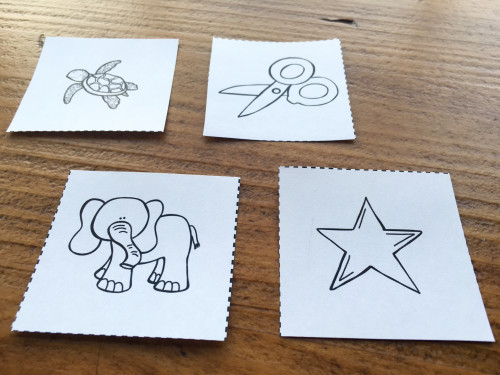
Initial and final sound identification
Learning to identify the first sound and last sound in a word are helpful skills for emergent readers. When they are able to do this orally, it helps them self-monitor when they apply this skill to print.
For example, if a child misreads the word “loro” as “pájaro,” they should notice that the word “pájaro” should start with the /p/ sound and attempt to self-correct the error. But if a child doesn’t have a solid awareness of how to “listen for” the first sound in the word, they’re not likely to recognize this type of mistake.
These skills can be practiced very simply (“Dime el primer/último sonido en la palabra _______.”). Students who struggle can best be served by practice in a small group setting.
Identifying phoneme placement in word
When I recently read Gorman and Gillam’s article “Phonological Awareness in Spanish: A Tutorial for Speech—Language Pathologists,” I learned about a phonemic awareness skill that is “new” to me: identifying phoneme placement in a word.
In one study, they found a significant correlation between students’ beginning reading skills and their ability to identify the position of a sound in the word.
An example of this type of task would be as follows:
Teacher: “Dónde está la /a/ en uña: al principio, en medio, o al final?”
Student: Al final.
Try using this simple sheet (included in the free download) to have students point to the place in a word where they hear a certain sound:

Additional notes about teaching phonological awareness
Although phonological awareness can have a big impact on student’s reading and writing, the great part is that you can help them develop it in just a few minutes per day! Keep activities fun and brief – and remember that you can use them as transitions or attention-getters in the classroom.
One other thing to keep in mind is that phonological awareness can develop through activities other than those that are just focused on phonological awareness. For example, as students learn to stretch out words and “listen for their sounds” to write them, they are developing their phonological awareness skills.
When students struggle with phonological awareness or don’t really seem to be participating in whole group activities, try pulling them in a small group. Small group phonological awareness activities can be most effective for struggling readers.
You can also try having students close their eyes when you have them “listen for” certain sounds or participate in phonological awareness activities. This helps them focus less on the visual stimuli around them and more on developing hearing and listening skills.
Conclusions
Do you have any additional Spanish phonological awareness activities to add? Please share in the comments below!
And don’t forget to sign up to receive all the phonological awareness freebies pictured in this post! If you haven’t signed up yet, you can get them by signing up here:
I’m currently working on a pack of small group Spanish phonological awareness activities, so I’ll let you know when those are ready. Also, tomorrow I will be posting about teaching phonics in Spanish!
As always, feel free to contact me if you have any questions!
Resources
Gorman, B. K., & Gillam, R. B. (2003). Phonological Awareness in Spanish: A Tutorial for Speech—Language Pathologists. Communication Disorders Quarterly, 25(1), 13-22.
Manrique, A. M. B., & Signorini, A. (1994). Phonological awareness, spelling and reading abilities in Spanish-speaking children. British Journal of Educational Psychology, 64, 429–439.

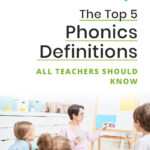


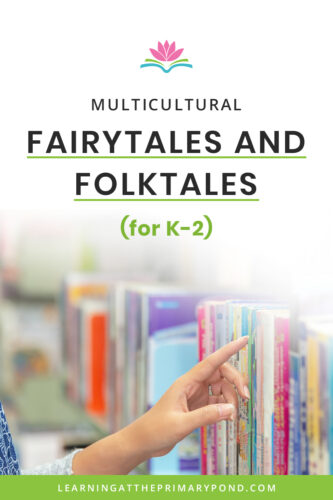








Hey Alison, Interesting post this one. Just one comment about it. As a native Spanish speaker I wanted to clarify something about rhyming. As you said, teaching how to read in English and Spanish is very different. We do it letter by letter and it’s sound. That’s why we don’t rhyme or teach how to rhyme at Latin American schools during the first years of school (K-1st) as a way to develop phonemic awareness. (But would be interesting to see how this works) We teach how to rhyme in higher grades as a Literary Genre. But more focused in exploring… Read more »
Ibeth, that is so interesting! Thanks for sharing this! I do not spend much time teaching rhyming, either, as I’ve found syllabication activities to be more useful. The articles I read did not compare the effectiveness of rhyming practice to other phonological awareness activities, but I would be interested to know how it “stacks up.” Thanks for reading and commenting!
This was wonderful! Thank you so much for the information!
Thank you so much for sharing your package! I have been using it all year as an intervention teacher and it has been tremendously helpful.
I’m so glad to hear that!! 🙂
Alison
Your material is great. I don’t speak Spanish, but do inservices in English that are translated into Spanish. I am interested in knowing about diphthongs and similar ways to teach them.
Alison,
Thank you so much for sharing your resources! I am very excited to start using some of your activities with my struggling readers.
You’re so welcome, Lizette! Glad they are helpful!
Alison
You are awesome Alison. Thank you so much for this helpful information as I am in my first year teaching in a dual language Kindergarten. ¡Muchas gracias!
De nada, Madeline! So glad this is helpful!
Alison
Querida Alison, I am really excited about all the helpful information you have provided. I am in a dual language school as interventionist in Spanish language. Muchas gracias!!!
I would like to know if it is possible to use the Phonological Awareness and the phonic strategies with any other program to teach students how to read and write .
Hola Jasmin, absolutely! I’ve used these same basic strategies with a couple of different programs. They’re pretty flexible!
Alison
Oh my word! Excellent information! Clearly written and I really appreciate how you supported your ideas with research. I just finished an online linguistics course and your site is very helpful in synthesizing all the information into user-friendly concepts and tasks. Thank you for this work!
Thanks, Suzy!! So glad this is helpful!! 🙂
Alison
Just what I needed! I’m a reading interventionist at a dual language school, and while I know the importance of phonological awareness to reading success, I was at a loss of how to adapt this to Spanish (since my Masters program was focused on English reading). I appreciate the thoughtful explanations and the resources. On behalf of my students, MUCHAS GRACIAS.
I’m SO glad this was helpful, Andrea!! Thanks so much for reading and for your sweet comment!!
Alison
Excellent resources. Thank you!!!!!
Hello Alison,
As a first year teacher I have struggled with teaching syllable segmentation because my non-native Spanish speakers struggle to know where one syllable ends and the other begins. What do you recommend for this? Do you teach specific segmentation patterns/rules beforehand?
With care,
Sandra
Hi Sandra! Do you mean when students practice orally? Or with written words?
Alison
I am following this. I would ask in both. What would you recommend? What resources do you have that can be used in a 2nd grade DUAL classroom? I seem to have extremely smart kids that struggle with blending when they read.
Thank you!
Hello Maria! I would say you do what you feel is best for your students, since you know their individual needs best! To help with blending, I have some resources that focus on Fluency and syllable practice that you may find helpful! I have included the link to the resource page. I hope you find it helpful!
https://www.teacherspayteachers.com/Store/Learning-At-The-Primary-Pond-Alison/Search:spanish
This is amazing!!! Easy ideas to bring back to the classroom. When a student is struggling with reading it most often comes back to phonemic awareness. Thank you!!!
Thank you, Donna!! I’m so glad that you found this post helpful! 🙂
For some reason it will not let me subscribe to get the freebie.
I’m so sorry about that Veronica! Any chance the email went into your Spam folder? Or are you having trouble submitting the form?
Hello, I am not seeing a form to enter my information for the download.
So sorry about that, Lauren! Try this link: Spanish Freebies
Thank you so much for sharing. I teach 1st grade Spanish (dual language) Please send me your wonderful materials.
Hey Mariana! Here’s a link to my blog. You’ll see tons of free resources/materials!
This is such great info. Thanks so much Alison. It’s great to see you so successful!!!
This is so helpful for me as I am a Bilingual Interventionist this year!
Thanks for your kind words, Kelly!
Hi. Thanks for this helpful info. I teach second grade and I would love to have your phonological awareness freebies. The link you posted in the description and in a comment below took me to a Freebie for Writing instead.
Thanks so much! Gracias!
Here’s the link you’re looking for! https://www.learningattheprimarypondresources.com/free-reading-intervention-toolkit